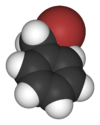Benzyl bromide
| |||
| Names | |||
|---|---|---|---|
| Preferred IUPAC name
(Bromomethyl)benzene | |||
| Other names
α-Bromotoluene Benzyl bromide | |||
| Identifiers | |||
| 100-39-0 | |||
| 3D model (Jmol) | Interactive image Interactive image | ||
| ChEBI | CHEBI:59858 | ||
| ChEMBL | ChEMBL1085946 | ||
| ChemSpider | 13851576 | ||
| ECHA InfoCard | 100.002.589 | ||
| 6294 | |||
| PubChem | 7498 | ||
| UNII | XR75BS721D | ||
| |||
| |||
| Properties | |||
| C7H7Br | |||
| Molar mass | 171.04 g·mol−1 | ||
| Appearance | colorless liquid | ||
| Odor | very sharp and pungent | ||
| Density | 1.438 g/cm3 | ||
| Melting point | −3.9 °C (25.0 °F; 269.2 K) | ||
| Boiling point | 201 °C (394 °F; 474 K) | ||
| Solubility | soluble in benzene, CCl4 miscible in ethanol, ether | ||
| Refractive index (nD) |
1.5752 | ||
| Hazards | |||
| Flash point | 70 °C (158 °F; 343 K) | ||
| Except where otherwise noted, data are given for materials in their standard state (at 25 °C [77 °F], 100 kPa). | |||
| | |||
| Infobox references | |||
Benzyl bromide, or α-bromotoluene, is an organic compound consisting of a benzene ring substituted with a bromomethyl group. It can be prepared by the bromination of toluene at room temperature in air, using manganese(IV) oxide as a heterogeneous catalyst. It is a colorless liquid that is decomposed slowly in water.
Benzyl bromide is used in organic synthesis for the introduction of the benzyl protecting group for alcohols and carboxylic acids.
Benzyl bromide is a strong lachrymator and is also intensely irritating to skin and mucous membranes. Because of these properties, it has been used in chemical warfare, both in actual combat and in training due to its irritating yet non-lethal nature.
Synthesis
Benzyl bromide can be synthesized by the bromination of toluene under conditions suitable for a free radical halogenation:
N-Bromosuccinimide may also be used in place of elemental bromine.
See also
References
- ↑ Merck Index (11th ed.). p. 1142.


